- What is ad attribution?
- The importance of attribution
- The problems with ad attribution
- Problem 1: Who gets credit?
- The different attribution models
- First-touch
- Last-touch
- Last non-direct
- Linear
- Time decay
- Position-based
- Problem 2: Which model should you use?
- Problem 3: How to attribute specific referrers
- Instapage and attribution
- Get better attribution with Instapage
When evaluating your marketing channels, it stands to reason that the more data you have, the more successful you’ll be.
Where that was once the case, the opposite is now becoming true. The types of data, points of information, and the number of tools that can help you make sense of it are countless.
Marketers aren’t short on data. They’re drowning in it. But, there’s a method helping them keep their head above water: ad attribution.
What is ad attribution?
In advertising, attribution refers to the process of tracking the referral sources of a particular user goal. That goal could be a signup, a download, a purchase, etc.
When the buyer’s journey is long and complicated, tracking the path to these goals is vital for every business. Attribution will give you an idea of your most profitable channels. If you know how a user found you, where they abandoned you, which channels got them to convert, etc., you can make better decisions about spending and optimization.
The importance of attribution
Marketers everywhere are have a big problem: Their big data is just too big:
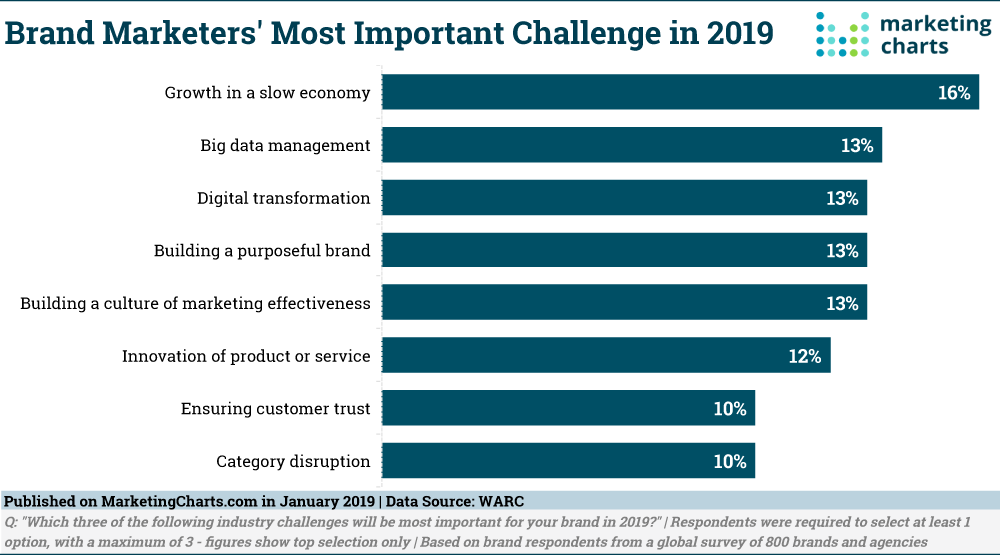
Managing the countless data points that come with each visitor across every medium, device, platform — it’s seemingly impossible to do. But when sorting through this data, advertisers don’t have a choice.
Attribution is the method by which advertising effectiveness is evaluated. And if you can’t determine the effectiveness of your ad campaigns — which channels are driving more ROI than others — you can’t know how to budget.
So, you may be surprised to find that just over a quarter of marketing professionals use attribution for all their campaigns.
Some said they have it set up but don’t analyze the results. Others said they don’t plan to use attribution at all:
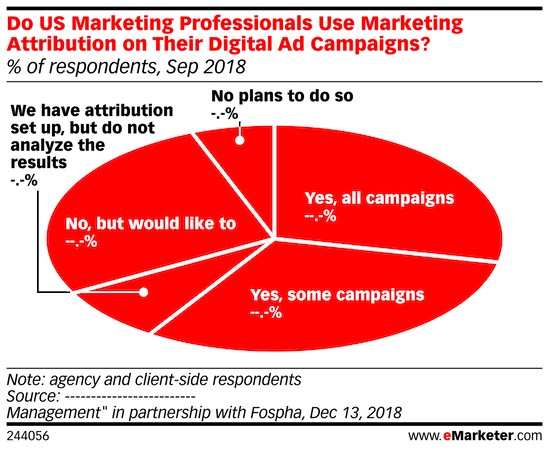
But a significant portion of marketers say they either use it for some campaigns, or don’t use it but would like to. Both categories reveal that there are barriers to adoption of attribution. And it’s not surprising. There are some major issues with the most common models.
The problems with ad attribution
In theory, attribution is a tactic that can pay dividends when it’s time to invest in new campaigns and optimize poor performers. In practice, however, it can be tough to determine how to attribute the referrers of profitable ad campaigns.
Ad attribution problem #1: Who gets credit?
The first major problem is determining how to credit referrers that contribute to a particular goal. With a long and complex buyer’s journey, how do you assign value to each touchpoint?
If a user enters through a Facebook ad, for example, but then reads a blog post, then visits your pricing page, and weeks later, buys on a post-click landing page after clicking a retargeting ad, what was the biggest contributor to conversion?
Was it Facebook for earning that first click? The retargeting ad? The post-click landing page?
It’s hard to tell.
That’s why there are a number of models to help you.
The different advertising attribution models
There’s no one-size-fits-all approach to attribution. Some models emphasize the first click that leads to the conversion, others, the last. Here’s who the different models decide to give credit to:
First-touch
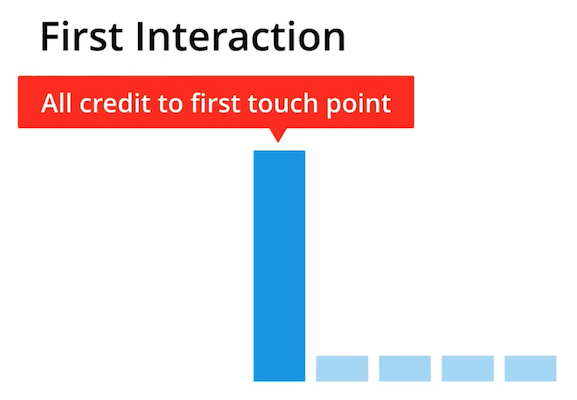
The first-touch model gives credit to the first touchpoint, and only the first. So, if your user moves from search to a post-click landing page, then is retargeted on Facebook, then clicks and converts on a different post-click landing page, the credit for the conversion will go to search.
Last-touch
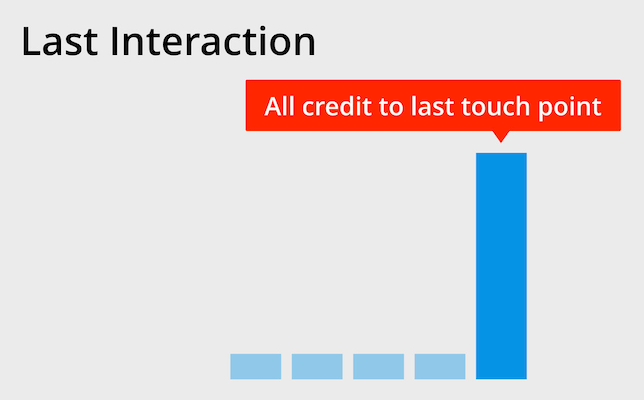
Like the first-touch model, last-touch gives credit to only one touchpoint. This time, though, it’s at the end of the interaction. If we’re using the same example as above (Search → Post-click page → Facebook → Post-click page), then the last post-click page gets all the credit for the conversion.
Last non-direct
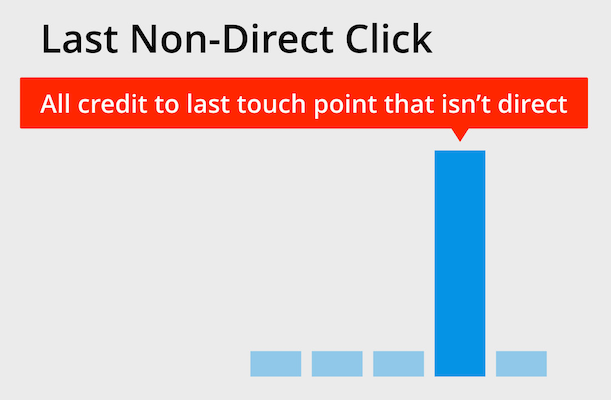
Like first and last click, last non-direct gives conversion credit to only one source. Unlike them, however, it excludes direct traffic. Since anyone navigating to your website directly is likely someone who has engaged with your brand before, last non-direct click assumes that direct is not the effector of the conversion, and therefore gives it no credit. The last source that was not direct gets 100% of the credit.
Linear

The linear model uses multi-touch attribution, so, unlike the previous two models, this one gives credit to more than one source. In the linear model, each touchpoint gets equal credit for the conversion.
Time decay
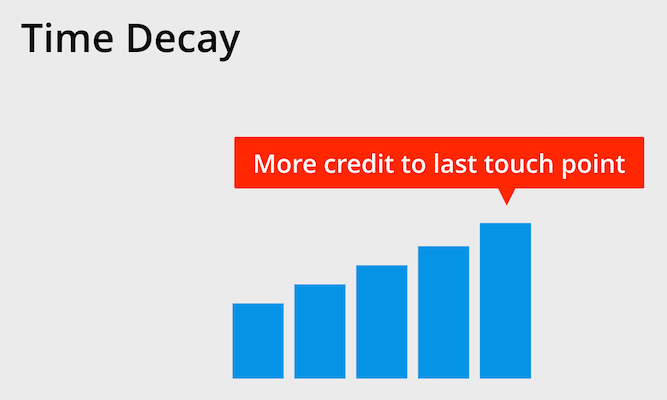
Another multi-attribution model, time decay gives credit based on the order in which the touchpoints are accesed. In our example (again: Search → Post-click page → Facebook → Post-click page), this would give most credit to the last post-click page, second most to Facebook, third to the original post-click page, and the least to search.
Position-based
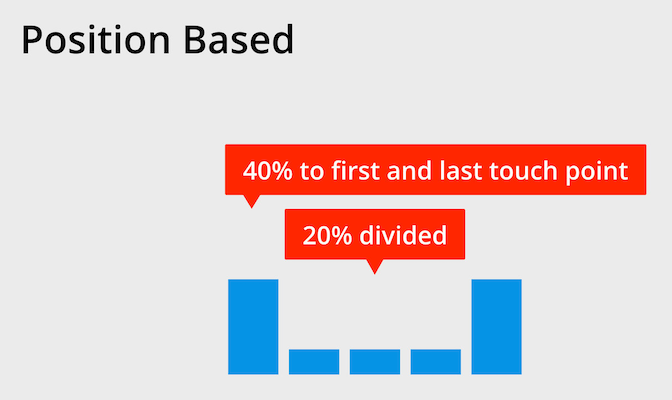
Another multi-touch ad attribution model, this one gives most credit to the first and last touchpoints (40% each), and divides the remaining 20% among the touchpoints between them.
Which model is the best?
Which source deserves credit depends on who you ask. It also depends on a host of other variables. Each model emphasizes a different part of the buyer’s journey as the greatest effector(s) of the goal action. Which model is the best? That depends…
Ad attribution problem #2: Which model should you use?
Problem two is related to the first. If you have several models for determining attribution, because there’s more than one way to give credit, then how do you know which to use?
The answer is complicated, and it varies from business to business. It depends on a lot — like sales cycle, industry, product, etc. — but there are some ways to determine which to use. Here are some pros, cons, and the best times to use.
First touch
First touch attribution should be used for demand generation. If you’re attempting to drive top-of-funnel metrics, this will give you an idea of what drew your visitor in and turned them to a lead.
The pros of this model are that it’s very easy to set up. The cons, however, are that it only accounts for one touchpoint in the marketing funnel.
Last touch
First touch attribution is particularly valuable for bottom funnel campaigns, when you’re trying to determine which sources led to a high-value conversion, like a sale.
The pros and cons of this model are like those of the first-touch model: They’re easy to set up, but they reveal only a very small part of the picture.
Last non-direct
The last non-direct model is useful for businesses that see a lot of direct conversions. The advantage of this method of attribution is that it shows the last channel that led to those conversions. It’s similar to last-click, in that it only shows a small portion of the journey, but it gives better information to businesses, like those in the B2B sector, who see most of their conversions on-site.
Linear
Linear attribution is valuable for telling a more comprehensive story than single attribution models can. If you have a longer path to conversion, this is a great way to evaluable every channel that led to the goal action.
The biggest advantage of this model is that it’s more comprehensive than the others. The biggest disadvantage is that it gives credit equally, when certain actions like reading a blog post or clicking an ad are two very different indicators of interest.
Time decay
The time decay model gives more credit to touchpoints later in the journey to conversion. This method of attribution is helpful to businesses with longer sales cycles, or ones aiming at bottom-funnel goals.
The benefit to this model is that it gives you an idea of the sources that most strongly contribute to conversion. However, it assumes that the sources that come just before the conversion are the most influential. This isn’t always the case.
Position based (or U-shaped)
As is the case with other multi-attribution models, position-based attribution is best used when your customer journey is long and complex.
The major benefit users get from this is similar to that of linear attribution: you get a more comprehensive picture of the customer journey. Like time decay attribution, though, you get the added valuation of key moments in the customer journey. Mainly, that’s the first and last touch. In essence, this is a multi-attribution method that combines first, touch, last touch, and linear models.
The downside, though, is the model’s assumption that first and last touch really deserve 40% of the credit for conversion. If you’re a marketing agency, for example, and your high-quality blog posts are what proved you’re worth hiring, they’ll get very little credit for conversion if the client found you on search and converted through direct.
Ad attribution problem #3: How do you attribute specific referrers?
The third problem is that evaluating them takes more than tracking channels.
As any marketer can attest to, each campaign comes with referrers within referrers. Your web pages, for example, may contain multiple calls-to-action. Your campaigns will have multiple ads spanning several keywords, your post-click landing pages will likely exist among other variations.
Attribution models can help broadly determine the path to purchase. To gain a better understanding of that path, you can use UTM parameters. These are pieces of text added to the end of your URL, which specify key details for attribution. There are five types:
- utm_source: Identify the advertiser, site, publication, etc. that is sending traffic to your property, for example: google, newsletter4, billboard.
- utm_medium: The advertising or marketing medium, for example: cpc, banner, email newsletter.
- utm_campaign: The individual campaign name, slogan, promo code, etc. for a product.
- utm_term: Identify paid search keywords. If you’re manually tagging paid keyword campaigns, you should also use utm_term to specify the keyword.
- utm_content: Used to differentiate similar content, or links within the same ad. For example, if you have two call-to-action links within the same email message, you can use utm_content and set different values for each so you can tell which version is more effective
When used together, these UTM codes can help you identify even the most detailed origins of a click. They can also help you avoid making miscalculations. In a blog post for Confluent Forms, David Kutcher offers an example:
For example, let's say you're an avid Twitter user, following recommendations to share the same link often. To avoid being flagged as duplicate content, you change the content accompanying the link, often with different text and hashtags.
If you're not using UTM codes, all of the traffic from those tweets will come to your Analytics looking the same, as a referral from Twitter. Sure, you'll have some of the metrics from within Twitter, but you won't be able to connect a Tweet to a Conversion.
This is really useful for evaluating more than just the channel. Maybe, for example, a hashtag was the reason for improvement in a Tweet’s performance. Maybe it was the time of day, or the text. With UTM parameters, there’s little you can’t track when it comes to the click.
The other problem UTM parameters solve is the inconsistent information that might come from analytics platforms. Not all platforms will use the same attribution model. Facebook, for example, uses last-touch attribution. If a Facebook ad is clicked and it results in a conversion, Facebook gets the credit. This won’t paint the entire picture for retargeting ads, which a user only sees if they’ve engaged with the advertiser first.
How Instapage Personalization attributes referrers
With UTM parameters, descriptive labeling conventions can help tell a more complete story in your analytics dashboard. In Instapage, for example, you can set up UTM parameters for each personalized experience you want to offer the people who click your link:
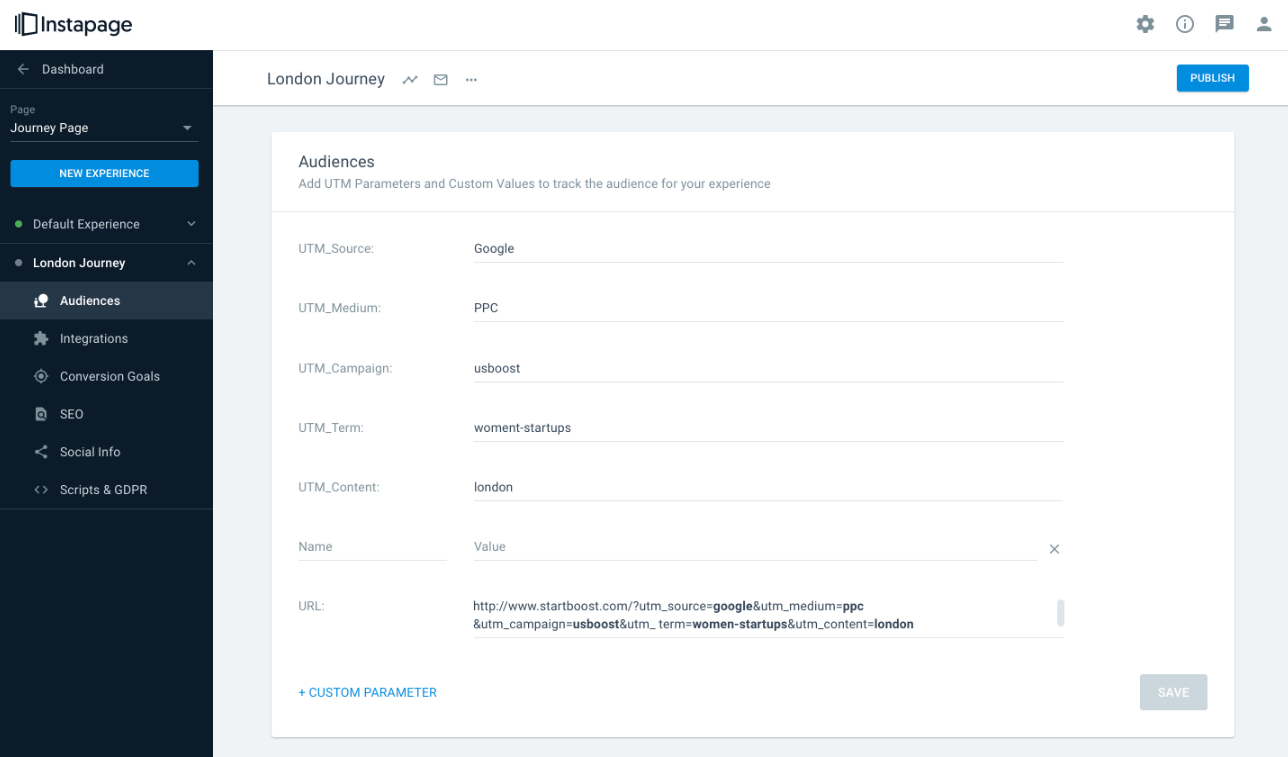

On your end, the analytics tool will show exactly what they experience. Each UTM parameter will help you sort through that heap of data more easily, based on your predefined labels.
Get started with a better kind of ad attribution
There’s no one-size-fits all model of ad attribution. Each is valuable in its own situation. Where B2B marketers may prefer multitouch, B2C businesses with a shorter purchase journey may not need the complexity.
Whichever you choose, UTM parameters are a valuable addition to minimize confusion between platforms that use different models, to help you sort through data better, and make better decisions based on greater detail.
Want to learn how you can provide better, more relevant user experiences with the help of ad attribution? Get a demo of the Instapage Personalization Solution.

Get a Personalization Demo
See how easy it is to create unique experiences for any audience you target.
